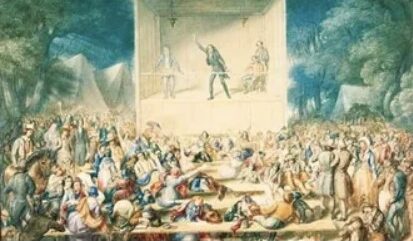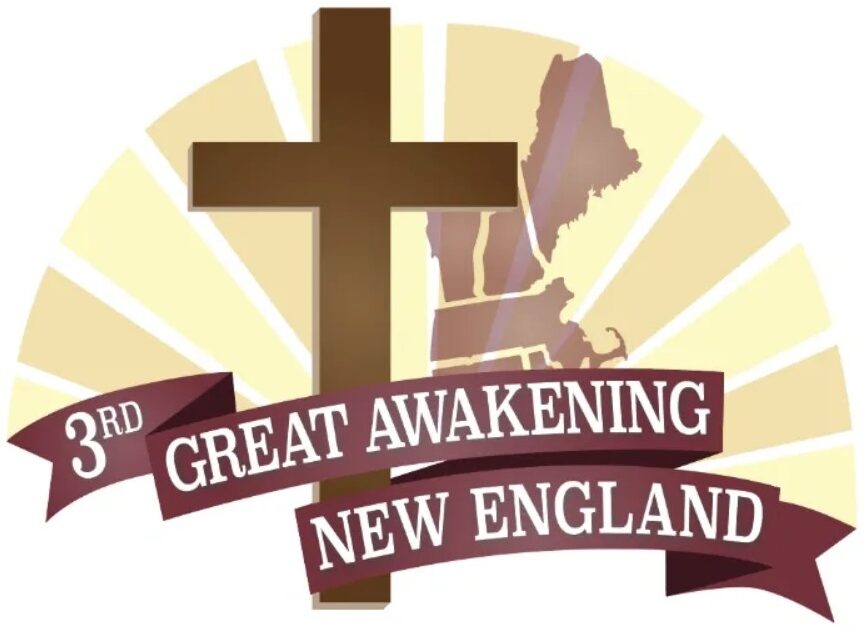
The First Great Awakening challenged the humanistic elements of the Enlightenment and focused the religions at the time off centralized bishops and state religions and on the person of Jesus Christ. Doing so, the revival stressed the depravity of man according to Calvinistic thought and led the intellectual classes to establish a nation centered in God.
The primary religions at the time were Calvinistic stressing predestination, the belief that God determined who would be saved before the foundation of the world and man being totally depraved was unable to come to God on His own. This error ignored 1 Timothy 2:4 which says “Who will have all men to be saved, and to come unto the knowledge of the truth.” This thought also denied 2 Peter 3:9 saying “The Lord is not slack concerning his promise, as some men count slackness; but is longsuffering to usward, not willing that any should perish, but that all should come to repentance.” Whatever errors the churches had, with much prayer, fasting and a focus on the need to repent in preaching moved God to send a great revival.
After the Revolutionary War was won and the country started expanding, the intellectual class cooled somewhat as rationalism worked its way around the world and the pioneers moved to new parts of the world seeking to make better lives for themselves in this world. An optimistic time where people were establishing a new nation, the Calvinistic beliefs of total depravity with an inability to improve themselves did not seem to fit. A Second Great Awakening started in the 1790s focusing on the lower classes and stressed the need to make a personal decision to come to Christ. The traditional, European based religion of the Reformation was being replaced with a new Armenian focus, a religion that stressed the free will of man coming to God on their own with no need for God to predestinate or even call people to come did ignore John 6:44 which showed “No man can come to me, except the Father which hath sent me draw him: and I will raise him up at the last day.” Both awakenings had errors, but the main focus of each taught man as fully sinful and deserving Hell for rebelling against a righteous God. All religion is imperfect as it is man’s attempt to approach a Holy, infinite, perfect God and the two awakenings taken together allowed religion to come to the marketplace of ideas with each person led to the Spirit and God’s Word to proper worship instead of being forced to a set of beliefs set by a state church. Both agreed with Romans 10:14-15 – “How then shall they call on him whom they have not believed? And how shall they believe in him of whom they have not heard? And how shall they hear without a preacher? And how shall they preach except they be sent? As it is written, How beautiful are the feet of them that preach the gospel of peace, and bring glad tidings of good things.”
RELIGION SPREADS ACROSS THE COUNTRY
Post-Revolutionary War, an optimistic nation moved west desiring to establish a new country, a new Eden as it were. In desiring a totally new country, they desired a new religion going to a more primitive form of Christianity resembling the church in New Testament times. Relying on themselves to start new lives, the people moving desired to find truth on their own through the Bible and not by the European model of religion that they left. New churches were spread throughout the frontier by the Second Great Awakening.
The Second Great Awakening expanded as the population spread out making large churches led by college educated and fully supported pastors increasingly difficult. In these rural districts, Baptists and Methodists and to a lesser extent, New Light Presbyterians filled the gaps. The Methodists used circuit riders to reach appreciative penitents. Baptists stressed the equality of believers and allowed people feeling the call to start new churches that would then ordain them. As the church would grow, they would train others with a call, helping them establish a new church and continue. These were popular pastors as they were part of society in general and were not expected to be treated like nobility. All of these also preached to, accepted and even trained slaves to be pastors showing this equality. With this pattern, the Baptists which had been persecuted in the First Great Awakening became the prominent religions of the frontier and most of the South.
The revival started in small doses in the original colonies then spread quickly throughout Kentucky, Tennessee, and the Ohio Valley. These churches were usually established or strengthened with camp meetings.
THE CAMP MEETING
The camp meeting often provided the first encounter with organized religion to settlers. They would often last several days with multiple preachers leading, with an emphasis on a person’s sins and a need to turn to Christ. With this emphasis, people would be saved and restored by personal repentance and a sense of personal salvation. With far more emotional preaching than before, hundreds and even thousands of people would be inspired by the Spirit and would respond with dancing, shouting and enthusiastic singing. Dickson Bruce states that most returning home would join or start a small, local church which would grow quickly proving the genuineness of their conversion (Bruce).
The website American History From Revolution to Reconstruction and beyond reports in their section The Second Great Awakening “The first camp meeting took place in July 1800 at Gasper River Church in southwestern Kentucky. A much larger one was held at Cane Ridge, KY, in August 1801, where between 10,000 and 25,000 people attended, and Presbyterian, Baptist, and Methodist ministers participated. It was this event that stamped the organized revival as the major mode of church expansion for denominations such as the Methodists and Baptists.” Many other minor religions stressing a personal relationship with Christ started seeking to return to the original, fundamental Christianity of the New Testament committed to achieve a personal relationship with Christ.
One of the leaders of the camp meeting movement was Charles Grandison Finney who tried to turn revivalism into a science that could be repeated. Preaching in New York’s “burned over district,” so called because of all the revivals, he sought to leave behind God’s reviving Spirit and use strictly emotional appeals to see conversions to Christ. McLaughlin said of Finney, “While emotionalism had long been the practice of revivalists, Finney was the first major religious figure to give the technique a calculated turn. His approach was revolutionary in that it abandoned the traditional notion that only God, through miracles, could induce the intense religious fervor that characterized a revival. As Finney saw it ‘all the laws of matter and mind remain in force’ at a revival which ‘consists entirely in the right exercise of the powers of nature’ and is a ‘purely philosophical (scientific) result of the right use of the constituted means’” (87).
Finney did preach the gospel and did focus on the sinfulness of man. However, by only focusing on an emotional call to convert with the emotional joy that followed, the burned-out district sprouted other heretical systems along with conversions from people following His Word. Emotionalism apart from God’s grace allowed false religions such as Mormonism, Jehovah’s Witnesses, Shakers, Seventh-Day Adventists, Millerites (people putting dates upon the return of Christ in violation of Matthew 24:36). Further heretical systems included the Fox sisters who led seances and formed the Plymouth Spiritualist Church which taught communion with the dead and many utopian societies such as Oneida Society that established communal living and group marriage. Elizabeth Cody Stanton mixed religion and social radicalism leading the charge for woman’s suffrage, temperance and abolition. We see the damage of thinking revival in a fully Armenian system ignoring God’s part in salvation can bring.
SOCIAL GOSPEL
A more practical and socially conscientious Christianity came out of the Second Great Awakening as religious leaders tried to bring Christian teachings to social problems. Evangelists started directly addressing issues such as slavery, greed and poverty. Later, Alice Tyler led Antebellum reforms and went fully into politics with prohibition of alcohol, women’s rights and abolition of slavery which came fully into view as more important than mere salvation. Converts to Christianity were taught that to achieve salvation they needed not only to repent against sin but had to work for the moral perfection of society. This was a call to be saved unto good works as called for in James 1:21-27 and was good as long as it was viewed as serving Christ and not merely working for salvation.
The Social Gospel led to some preaching holiness (the idea that sinlessness can be achieved in this life), Christian teachings to affect societies in many religions was often extent with some religions leaving their first love and going straight into politics, often getting both wrong through their actions.
CONCLUSION
The two great awakenings well established this nation as one blessed by God as it sought to serve Him in Spirit and in Truth. Far from perfect, it tried to walk correctly and change when proved wrong. The First Great Awakening established a focus on Christ and led to a Constitution honoring God and a nation blessed by Him. The First Great Awakening was Calvinistic and led to the Second Great Awakening with a more democratic and Armenian outlook. The leaders of both tended to go to the excesses of their beliefs of total depravity and free will. Each shaped the other and led to a country that allowed freedom of religion that allowed Christianity to flourish even as it countenanced error.
American History website tells us in its article on The Second Great Awakening that it “exercised a profound impact on American history. The numerical strength of the Baptists and Methodists rose relative to that of the denominations dominant in the colonial period – the Anglicans, Presbyterians and Congregationalists. Among the latter, efforts to apply Christian teaching to the resolution of social problems presaged the Social Gospel of the late 19th century. America was becoming a more diverse nation in the early to mid-19th century, and the growing differences within the American Protestantism reflected and contributed to this diversity.” With the two Great Awakenings challenging the religious thinking of the time, God developed a more perfect union in which any remnant of European state-run religious tyranny was no longer possible. America the free politically became America the free religiously and people honored Christ as they felt led and not by force from the state. As they got the church correct, the politics followed.
WORKS CITED
Bruce, Dickson D., Jr, And They All Sang Hallelujah: Plain Folk Camp-Meeting Religion, 1800-1845
McLaughlin, William H., The American Evangelicals, 1800-1900, Peter Smith, INC., 1985
